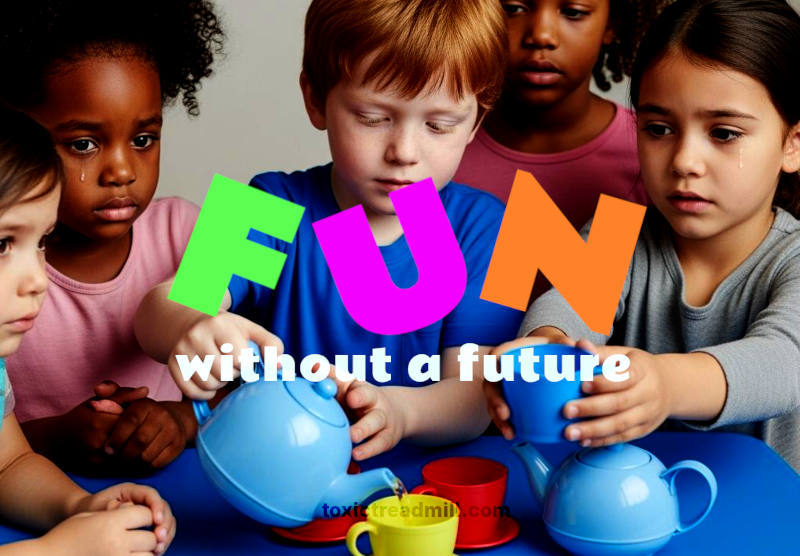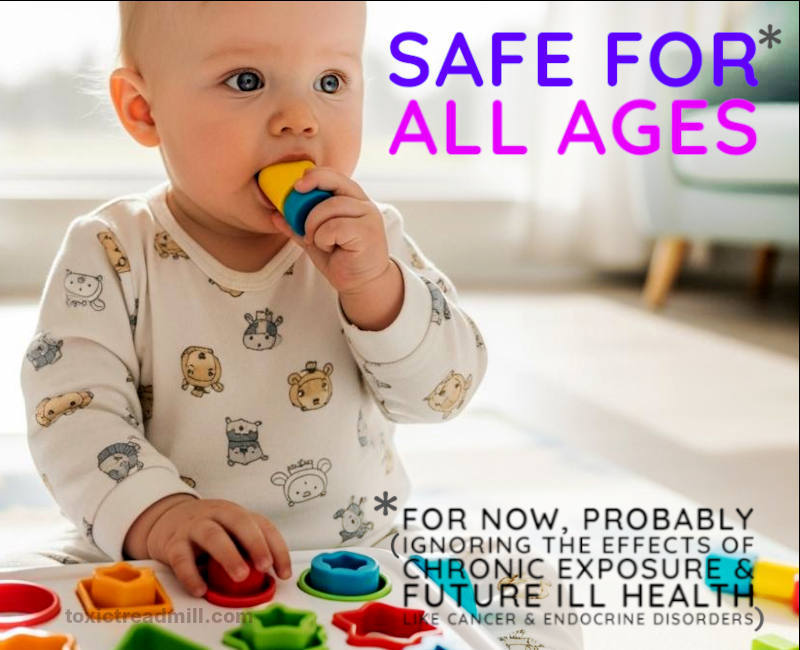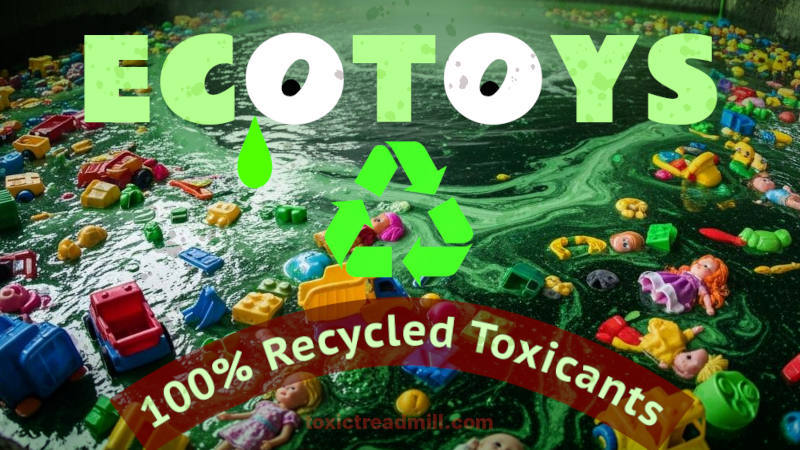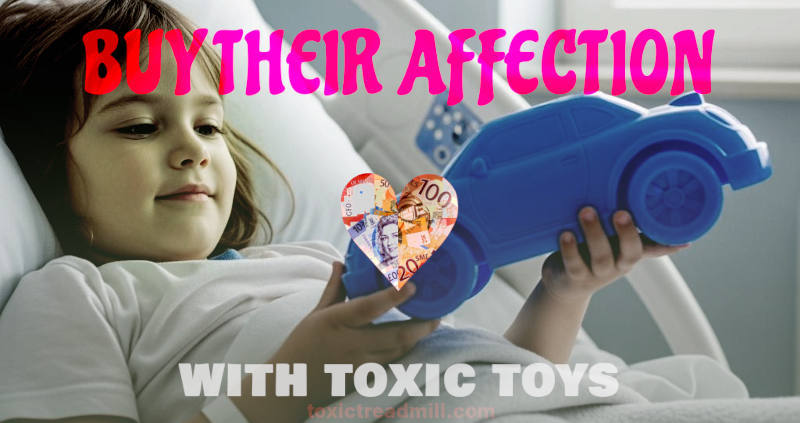Toxic Treadmill
Evidence for a Poisoned Planet
Toxic Toys & Games
The global toy industry uses complex mixtures of materials such as plastics, dyes, coatings, and other additives to achieve desired aesthetic, mechanical, and functional properties. However, these components may harbour hazardous chemicals that pose invisible risks to human health, particularly in children who are most vulnerable because of their physiological development and behaviour patterns.
Hazardous Additives in Toy Materials
Plastics, which account for about 90% of raw materials in toy production, typically involve petrochemical-based polymers such as polyethylene (PE), polypropylene (PP), polyvinyl chloride (PVC), and polystyrene (PS). These materials contain an array of additives including plasticizers, flame retardants, UV stabilizers, and colourants that are not chemically bound to the polymer matrix and may leach over time. The migration of additives such as phthalates and bisphenol A (BPA) from these plastics has been linked to endocrine disruption, contributing to systemic disorders and developmental toxicity even at low exposure levels. In addition, hazardous flame retardants such as polybrominated diphenyl ethers (PBDEs) and hexabromocyclododecanes (HBCDDs) are frequently detected in toy plastics, despite regulations aimed at reducing their use.

Dyes and coatings applied to toys also contain hazardous substances, including heavy metals like lead and cadmium, which are used to provide brightness and durability; these heavy metals frequently exceed regulatory thresholds, especially in low-cost toys produced with recycled materials. Moreover, the use of colourants may lead to the inclusion of other toxic compounds, including organotin compounds, white pigments that contain titanium dioxide, and other stabilizers that have been associated with carcinogenic outcomes.
Beyond the primary components, the manufacturing process often produces by-products and impurities—such as brominated dioxins, furans, and short-chain chlorinated paraffins (SCCPs)—that are frequently not removed by standard processing and persist in the final product, contributing to the overall toxic burden. These hidden contaminants can act synergistically, potentiating health risks due to combined low-dose exposures over time.
Exposure Pathways
Children are especially susceptible to the adverse health effects of these toxicants due to unique exposure pathways such as hand-to-mouth behaviours, prolonged dermal contact, and the ingestion of small fragments of plastic. Oral ingestion of leached contaminants from toys has been estimated to account for a significant fraction of total exposure to hazardous flame retardants. Studies indicate that even when chemicals are within regulatory limits, they can still contribute up to 31–58% of total exposure (from all sources, not just toys) for specific compounds. Dermal uptake from contact with contaminated surfaces further increases the risk, especially when additives migrate from the surface of plastics or are present in coatings worn through normal use.
In addition to direct exposure during play, secondary exposure occurs as hazardous materials leach into the environment from post-use waste. Recycling processes, particularly those that rely on low-quality or manually sorted plastic waste, may reintroduce legacy additives into new products, thereby perpetuating a 'risk cycle'. Manufacturing by-products, effluents in waste water, and incineration emissions from plastic waste contribute to environmental contamination, further exposing populations to toxicants via contaminated air, water, and soil.
Systemic Health Hazards
Chronic exposure to the toxicants present in toy materials has been associated with a range of systemic health effects that are often invisible until long after the initial exposure. It means the link between the exposure and the illness may be missed by parents, guardians, and health workers; a problem with many environmental pollutants.

Substances found in some toys, such as bisphenol A (BPA), phthalates, and certain heavy metals, can induce endocrine disruption which leads to systemic disorders. This can cause infertility and make both female and male reproductive materials toxic (capable of producing damaged offspring). Damage caused by the disruption of hormone signalling pathways can include developmental delays, and metabolic syndrome.
Oxidative stress is another invisible risk linked to exposure to these toxicants. The generation of reactive oxygen species (ROS) through the metabolic processing of chemicals like heavy metals, BPA, and phthalates can overwhelm cellular antioxidant defences, leading to oxidative damage to lipids, proteins, and DNA. Chronic oxidative stress contributes to a wide range of disorders, including neurodegenerative diseases and cancer.
Neurological impairments have particularly alarming implications for children, whose developing brains are more vulnerable to toxic insults. Exposure to lead, mercury, certain phthalates, and brominated flame retardants has been correlated with reduced IQ, learning disabilities, behavioural disorders such as ADHD, and other neurodevelopmental deficits. The mechanisms underlying these effects often involve hormonal disruption and neuroinflammation, which can have long-lasting impacts that persist into adulthood.
Emerging evidence also connects exposure to toxicants with gut dysbiosis, a state in which the balance of the gut microbiota is altered in a manner that negatively affects overall health. Disruption of gut microbial communities has been observed with exposure to endocrine disruptors such as BPA and various phthalates. Recent studies suggest that altered gut microbiota may contribute to systemic inflammation and metabolic disorders. Although the direct links between gut dysbiosis and long-term exposure to toy-related toxicants require further investigation, the associations with systemic toxicity are increasingly recognized.
Carcinogenicity is an additional risk associated with chronic exposure to hazardous materials from toy components. Several additives, including heavy metals such as cadmium and chromium, as well as brominated flame retardants and certain plasticizers, have been implicated in carcinogenic processes. The cancer risk arises from multiple mechanisms, including direct DNA damage induced by oxidative stress, epigenetic alterations, and disruption of normal hormonal regulation.
Hazardous By‐Products from Manufacturing and Recycling
The manufacturing process of toys often produces by-products that are not adequately removed from the final product. These by-products can include polymerization side-products, residual solvents, and impurities from catalysts and stabilizers that were used to enhance the physical properties of plastics. Such compounds, even when present at low levels, contribute to the overall toxic burden of toys and may be released over time during use, particularly when the product is exposed to heat or UV radiation.
Recycling processes present another significant source of concern. Recycled plastics, often derived from post-use waste that includes electronics and other consumer products, may contain legacy additives that have been phased out in new production but persist in older materials. These legacy additives, such as banned brominated flame retardants and phthalate plasticizers, continue to be reintroduced into consumer products via recycling, thereby undermining regulatory efforts and exposing users to chronic low-dose toxicants. Post-use waste from toy manufacturing generates effluents and environmental releases of hazardous chemicals that contaminate soil and water systems, thereby broadening human exposure through indirect pathways.

Moreover, the burning or incineration of plastic waste generates additional hazardous compounds, including dioxins and polycyclic aromatic hydrocarbons (PAHs), which further contribute to the invisible risks associated with plastic toy materials. These effluents and by-products may persist in the environment for long periods, bioaccumulate in food chains, and eventually lead to systemic toxicity and potential carcinogenic effects.
Specific Chemical Classes and Their Adverse Effects
Endocrine Disruptors
Phthalates and BPA, widely used as plasticizers and in polycarbonate plastics respectively, are among the most thoroughly investigated endocrine-disrupting chemicals (EDCs) in toy materials. These substances mimic or interfere with the action of natural hormones, particularly estrogens, and have been associated with hormonal imbalances that lead to reproductive toxicity, developmental abnormalities, and metabolic disorders. Animal and epidemiological studies support the notion that even low-dose exposures during critical developmental windows can have permanent adverse effects on the endocrine system.
Brominated Flame Retardants
Brominated flame retardants (BFRs), such as PBDEs and HBCDDs, are intentionally added to plastics to reduce flammability but are now recognized as persistent organic pollutants (POPs) with significant toxicological profiles. These compounds exhibit bioaccumulation and are linked to neurodevelopmental deficits, endocrine disruption, and immune system impairment, with a risk profile that includes potential carcinogenic effects. Exposure assessments indicate that children may receive a significant fraction of their total BFR exposure through direct contact with toys.
Heavy Metals
Heavy metals including lead, cadmium, chromium, and nickel are frequently detected in toy coatings and paints used to impart colour and brightness. These metals are neurotoxic, can interfere with normal enzymatic functions, and have been linked to oxidative stress, which in turn predisposes to carcinogenesis. Lead, in particular, is associated with irreversible cognitive deficits and developmental delays in children, while cadmium exposure is linked to kidney damage and an increased risk of cancer.
Per- and Polyfluoroalkyl Substances (PFAS)
Although traditionally associated with food packaging and water-resistant textiles, PFAS are emerging concerns in plastic-based consumer products due to their extreme persistence and potential to disrupt metabolism. Their resistance to environmental degradation leads to long half-lives in human tissues, and epidemiological links have been established between PFAS exposure and dyslipidemia, thyroid dysfunction, and a higher risk for estrogen receptor-positive breast cancers.
Volatile and Semi-Volatile Organic Compounds (VOCs and SVOCs)
The use of various solvents and residual monomers during the polymerization process results in the presence of VOCs and SVOCs that contribute notably to the off-odours of certain plastic toys. These chemicals, including aromatic hydrocarbons such as naphthalene and phenol derivatives, have been associated with irritation, systemic toxicity, and potential neurotoxic effects via sensory irritation and activation of transient receptor potential (TRP) channels. Although the concentration of these compounds can be below acute toxicity thresholds, chronic low-dose exposure remains a significant concern for vulnerable populations.
Mechanistic Pathways of Toxicity
The diverse spectrum of chemicals identified in toy materials can impact human health via several mechanistic pathways. Endocrine disruption occurs when additives such as BPA, phthalates, and certain heavy metals interact with hormone receptors, leading to altered gene expression and dysregulation of normal physiological processes. In parallel, these chemicals may induce oxidative stress by promoting excessive generation of reactive oxygen species (ROS) that overwhelm cellular antioxidant systems, leading to lipid peroxidation, protein denaturation, and DNA damage that cumulatively contribute to carcinogenesis.
Neurological toxicity is another predominant mechanism, wherein exposure to heavy metals like lead and mercury, as well as certain organic compounds such as PBDEs, results in the disruption of neurotransmitter systems and interference with neurodevelopmental signalling pathways. These disruptions can manifest as reduced IQ, behavioural abnormalities, and other neurodevelopmental impairments that may not become apparent until later in life. Additionally, toxicants that induce chronic systemic inflammation and oxidative stress may contribute indirectly to gut dysbiosis by altering the gut epithelial barrier or influencing microbial community structures.
Long-Term and Chronic Exposure Implications
Chronic low-dose exposure to hazardous chemicals found in toys has been linked to insidious health effects that manifest over extended periods. Prolonged exposure to endocrine disruptors may lead to cumulative reproductive and metabolic disorders, while sustained oxidative stress is implicated in the pathogenesis of neurodegenerative diseases and cancer. Even when individual exposures fall below current regulatory limit values, simultaneous exposure to multiple chemicals may lead to additive or synergistic effects that are not adequately captured by conventional risk assessments. Moreover, post-use waste from plastics contributes to environmental contamination; hazardous residues from degraded toys in landfills or incinerators can leach into soil and water and eventually enter the food chain, thereby perpetuating chronic exposure in the general population.

Additionally, workers involved in the manufacturing and recycling of plastic toys face elevated exposure risks. These occupational exposures are compounded by inadequate regulation of emerging waste streams and contaminated recycled materials that reintroduce legacy additives into new products, thus prolonging an individual's lifetime cumulative dose and intergenerational risk.
Regulatory and Mitigation Considerations
Regulatory frameworks such as the European Union Toy Safety Directive, REACH, RoHS, and various national standards have been established to limit the concentrations of hazardous substances in toys. Despite these efforts, studies indicate that many low-cost toys still exceed recommended limits for toxicants like lead and cadmium, particularly when produced in regions with lax enforcement and then recycled into new products. The challenge of legacy additives from older materials and recycling processes continues to undermine risk reduction measures, prompting calls for stricter regulation and improved screening measures during production and post-use waste management.
Moreover, advances in analytical chemistry—such as the use of gas chromatography-mass spectrometry (GC-MS), liquid chromatography-tandem mass spectrometry (LC-MS/MS), and bioassays including Microtox® and XenoScreen YES/YAS™—are enabling a more accurate quantification and hazard evaluation of the migrating toxicants, supporting better risk management strategies. These technological improvements are critical for defining risk thresholds that account for cumulative low-dose exposures, mixture effects, and long-term outcomes such as cancer, neurological disorders, and gut dysbiosis.
Summary
Toxicants present in toy materials are an underappreciated source of chronic exposure, with the potential to trigger a range of adverse health outcomes. The invisible risks associated with these chemicals include systemic toxicity, oxidative stress, neurotoxicity, and carcinogenicity. They are compounded by multiple exposure routes, including direct contact with contaminated surfaces, ingestion of leached chemicals, and secondary environmental exposures.
Emerging evidence suggests that even below-threshold exposures to single toxicants might not fully capture the risk posed by cumulative and synergistic effects arising from multiple compounds found in plastics, dyes, coatings, and post-use waste. Recycling adds another layer of complexity. Recycled plastics, particularly those sourced from post-use waste, are frequently contaminated with legacy chemicals that were once restricted or banned, yet persist in the environment and re-enter consumer products.
Mechanistic insights into how these toxicants exert their effects are also critical. For example, oxidative stress induced by chemicals such as heavy metals and plasticizers drives genomic instability and has been implicated in the onset of cancers and neurodegenerative diseases. Similarly, endocrine-disrupting chemicals interfere with normal hormonal synthesis and signalling pathways, leading to a range of developmental disorders that manifest over time. The role of these pathways in triggering gut dysbiosis is an emerging area of research that underscores the interconnectedness of environmental toxicants and systemic health effects.
References
Denk, P., Velasco-Schön, C., & Buettner, A. (2017). Resolving the chemical structures of off-odorants and potentially harmful substances in toys—example of children’s swords. Analytical and bioanalytical chemistry, 409, 5249-5258.
Fatunsin, O. T., Oluseyi, T. O., Drage, D., Abdallah, M. A. E., Turner, A., & Harrad, S. (2020). Children's exposure to hazardous brominated flame retardants in plastic toys. Science of The Total Environment, 720, 137623.
Flaws, J., Damdimopoulou, P., Patisaul, H. B., Gore, A., Raetzman, L., & Vandenberg, L. N. (2020). Plastics, EDCs and health. Endocrine Society: Washington, DC, USA.
Gul, D. E. S., Gul, A., Tanoli, A. K., Ahmed, T., & Mirza, M. A. (2022). Contamination by hazardous elements in low-priced children’s plastic toys bought on the local markets of Karachi, Pakistan. Environmental Science and Pollution Research, 29(34), 51964-51975.
Negev, M., Berman, T., Reicher, S., Sadeh, M., Ardi, R., & Shammai, Y. (2018). Concentrations of trace metals, phthalates, bisphenol A and flame-retardants in toys and other children's products in Israel. Chemosphere, 192, 217-224.
Santos, M., Araripe, E., Hohrenk-Danzouma, L., & Zeidler, V. G. Z. (2025). The Hidden Risks of Recycled Plastic Toys: A Literature Review on Legacy Additives and Child Safety. Sustainability & Circularity NOW, 2(continuous publication).
Suwal, A., Prajapati, M., & Shah, R. C. (2023). Assessment of Toxic Heavy Metal Content in Children Toys. Khwopa Journal, 5(2), 147-162.
Szczepańska, N., Namieśnik, J., & Kudłak, B. (2016). Assessment of toxic and endocrine potential of substances migrating from selected toys and baby products. Environmental Science and Pollution Research, 23, 24890-24900.